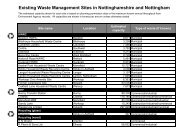Nottinghamshire Common Assessment Framework Handbook
Nottinghamshire Common Assessment Framework Handbook
Nottinghamshire Common Assessment Framework Handbook
You also want an ePaper? Increase the reach of your titles
YUMPU automatically turns print PDFs into web optimized ePapers that Google loves.
2.1<br />
Rationale for the Lead Professional<br />
The lead professional contributes to the delivery of early intervention to children, young<br />
people and families by taking the lead in coordinating provision and acting as the single<br />
point of contact when a range of services are involved in providing integrated support to<br />
a child or young person and their family following a <strong>Common</strong> <strong>Assessment</strong>.<br />
This is outlined in the Statutory Guidance Supporting Section 10 (Inter-Agency<br />
Cooperation) and Section 11 (Safeguarding and Promoting the Welfare of Children) of<br />
Children Act 2004. All local authorities and relevant partners have to take account of this<br />
guidance. If they decide to depart from it, they must have clear reasons for doing so.<br />
2.2<br />
Vision and Core Functions<br />
for the Lead Professional<br />
Vision<br />
All children and young people with additional needs who<br />
require support from more than one practitioner should<br />
experience a seamless and effective service in which one<br />
practitioner takes a lead role to ensure that services are coordinated,<br />
coherent and achieving intended outcomes<br />
Core functions of the Lead Professional<br />
Act as a single<br />
point of contact<br />
for the child or<br />
family<br />
Co-ordinate the<br />
delivery of actions<br />
agreed by the<br />
practitioners<br />
involved<br />
Reduce overlap<br />
and inconsistency<br />
in the services<br />
received<br />
2.3<br />
The role of the Lead Professional<br />
The lead professional contributes to the delivery of early intervention to children, young<br />
people and families by taking the lead in coordinating provision, and acting as the single<br />
point of contact when a range of services is involved in providing integrated support to<br />
a child or young person and their family following a <strong>Common</strong> <strong>Assessment</strong>. The lead<br />
professional could be any practitioner from across the children and young people’s<br />
workforce, who is working with a child as part of his/her work. The group of practitioners<br />
working with a child agree together with the family who would be best placed to be the<br />
lead professional. This is usually the practitioner working most closely with the family,<br />
13



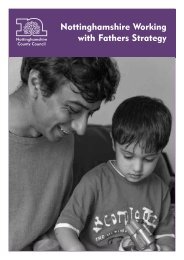
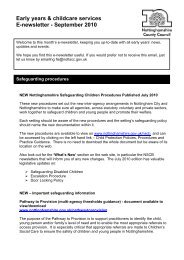


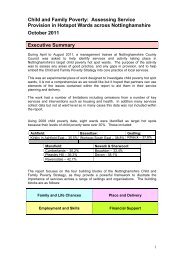

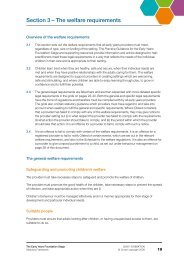
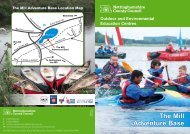


![Every Parent Matters [PDF 463KB] - Nottinghamshire County Council](https://img.yumpu.com/47250686/1/184x260/every-parent-matters-pdf-463kb-nottinghamshire-county-council.jpg?quality=85)


![School Employee Domestic Violence and Abuse Policy [PDF 228KB]](https://img.yumpu.com/46294446/1/184x260/school-employee-domestic-violence-and-abuse-policy-pdf-228kb.jpg?quality=85)
